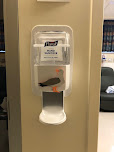Our daily lives seem to be getting more and more complex. We must remember so many things (taking our car keys, remembering all of our passwords, etc.) it is no wonder that we make mistakes. It is difficult to remember things that we don’t do regularly. With all the distractions that come at us daily, we frequently “slip” and forget to do something.
When that the “slip” is minor (recently I had to return to my office to get my car keys before heading home) we shouldn’t worry about it too much. But, if the error could result in significant harm to someone, then that is a different story.
Experts in safety list THREE levels of error prevention. The first level is education. So, when a young clinician or nurse forgets to do something, we might meet with them and remind them of the importance of the task that they did not do. If, in fact, they did not know the importance of the task, this may solve the problem. However, if they already knew of the importance, but got distracted in their work and just forgot to do it, then re-educating them about the task is not a very powerful way to prevent the “slip” from re-occurring.

 I am writing again about mistake proofing in this week’s blog because I saw three interesting uses of affordances on rounds this week. The first two were clever ways to get people to clean their hands before entering a patient’s room. The second was on the floor in the corridor outside of the Pediatric ED, in a place where people frequently leave beds, stretchers, and wheelchairs. This is a serious safety hazard. If there was a fire and we had to quickly move children out of the ED, we would have to move the misplaced equipment first. Recently, we put red tape on the floor in the places where the equipment is usually left. This is a great test of change. We believe that the red tape on the floor in front of the medical gas shutoff valves is the main reason why people don’t block the valves with equipment. Why not try the same method to keep equipment from being left in a narrow corridor? Please see the photos of the three new affordances that I saw this week below.
I am writing again about mistake proofing in this week’s blog because I saw three interesting uses of affordances on rounds this week. The first two were clever ways to get people to clean their hands before entering a patient’s room. The second was on the floor in the corridor outside of the Pediatric ED, in a place where people frequently leave beds, stretchers, and wheelchairs. This is a serious safety hazard. If there was a fire and we had to quickly move children out of the ED, we would have to move the misplaced equipment first. Recently, we put red tape on the floor in the places where the equipment is usually left. This is a great test of change. We believe that the red tape on the floor in front of the medical gas shutoff valves is the main reason why people don’t block the valves with equipment. Why not try the same method to keep equipment from being left in a narrow corridor? Please see the photos of the three new affordances that I saw this week below.The third level of mistake proofing is the most powerful. It blocks the error by not letting you get to the next step without doing the important task. Think of a device on my office door where it would not let me open the door to leave unless I had my car keys in my pocket. A real-life example of this happens when you try to buy something online, but forget to enter the CVV number. The software won’t let you get to the next step. Level 3 mistake proofing methods are often called constraints. The more serious the potential harm from an error, the more important it is to get to level THREE.
 Let’s celebrate our outstanding Environmental Service Workers
Let’s celebrate our outstanding Environmental Service Workers
This week is Environmental Services (EVS) and Housekeeping Week (Sept. 13—19) and I want to take time to recognize the contributions of our EVS staff. They work very hard to keep our facilities clean. In the face of COVID-19, our hospital colleagues have displayed an unwavering commitment to the health and safety of our patients and each other. They are playing a vital role in keeping everyone safe through proper cleaning and disinfecting.
Cleanliness is everyone’s job at GBMC, but our EVS staff members are the experts in cleaning and work tirelessly to get the job done. There are over 100 EVS associates working around-the-clock at GBMC in a variety of roles, servicing over 1.2 million square feet of facility. So, please join me in honoring all the men and women of EVS!
Neonatal Nurses Day...
This past Tuesday (9/15) was Neonatal Nurses Day. It’s a day to honor our nursing colleagues who care for our tiniest and most vulnerable patients. With more than 4,500 babies born at GBMC annually, we are very fortunate to have such a fabulous NICU team. Please join me in thanking them.


No comments:
Post a Comment
Thank you for taking time to read "A Healthy Dialogue" and for commenting on the blog. Comments are an important part of the public dialogue and help facilitate conversation. All comments are reviewed before posting to ensure posts are not off-topic, do not violate patient confidentiality, and are civil. Differing opinions are welcome as long as the tone is respectful.